Question 1.
Fill in the blanks.
- i) A tangent to a circle intersects it in ——— point(s). (one)
- ii) A line intersecting a circle in two points is called a ———. (secant)
- iii) The number of tangents drawn at the end of the diameter is ———. (two)
- iv) The common point of a tangent to a circle and the circle is called ———. (point of contact)
- v) We can draw ——— tangents to a given circle. (infinite)
Question 2.
A tangent PQ at a point P of a circle of radius 5 cm meets a line through the centre O at a point Q so that OQ = 12 cm. Find length of PQ.
Answer:
Given: A circle with centre O and radius OP = 5 cm
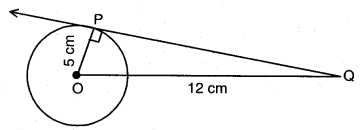
We know that ∠OPQ = 90°
Hence in △OPQ
OQ2= OP2+ PQ2
[∵ hypotenuse2= Adj. side2+ Opp. side2]
122= 52+ PQ2
∴ PQ2= 144 - 25 .
PQ2= 119
PQ = √119
Question 3.
Draw a circle and two lines parallel to a given line such that one is a tangent and the other, a secant to the circle.
Answer:
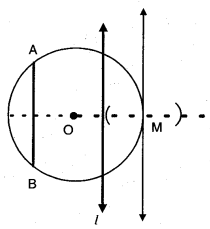
Steps:
- Draw a circle with some radius.
- Draw a chord of the circle.
- Draw a line parallel to the chord intersecting the circle at two distinct points.
- This is secant of the circle (l).
- Draw another line parallel to the chord, just touching the circle at one point (M). This is a tangent of the circle.
Question 4.
Calculate the length of tangent from a point 15 cm. away from the centre of a circle of radius 9 cm.
Answer:
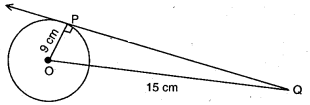
Given: A circle with radius OP = 9 cm
A tangent PQ from a point Q at a distance of 15 cm from the centre, i.e., OQ =15 cm
Now in △POQ, ∠P = 90°
OP2+ PQ2- OQ2
92+ PQ2= 152
PQ2= 152- 92
PQ2= 144
∴ PQ = √144 = 12 cm.
Hence the length of the tangent =12 cm.
Question 5.
Prove that the tangents to a circle at the end points of a diameter are parallel.
Answer:
A circle with a diameter AB.
PQ is a tangent drawn at A and RS is a tangent drawn at B.
R.T.P: PQ ‖ RS.
Proof: Let ‘O’ be the centre of the circle then OA is radius and PQ is a tangent.
∴ OA ⊥ PQ ……….(1)
[∵ a tangent drawn at the end point of the radius is perpendicular to the radius]
Similarly, OB ⊥ RS ……….(2)
[∵ a tangent drawn at the end point of the radius is perpendicular to the radius]
But, OA and OB are the parts of AB.
i.e., AB ⊥ PQ and AB ⊥ RS.
∴ PQ ‖ RS.

O is the centre, PQ is a tangent drawn at A.
∠OAQ = 90°
Similarly, ∠OBS = 90°
∠OAQ + ∠OBS = 90° + 90° = 180°
∴ PQ ‖ RS.
[∵ Sum of the consecutive interior angles is 180°, hence lines are parallel]
Question 1.
Choose the correct answer and give justification for each.
(i) The angle between a tangent to a circle and the radius drawn at the point of contact is
- a) 60°
- b) 30°
- c) 45°
- d) 90°
Answer: [ d ]
If radius is not perpendicular to the tangent, the tangent must be a secant i.e., 90°.
(ii) From a point Q, the length of the tangent to a circle is 24 cm. and the distance of Q from the centre is 25 cm. The radius of the circle is
- a) 7 cm
- b) 12 cm
- c) 15 cm
- d) 24.5 cm
Answer: [ a ]
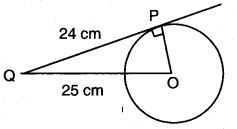
O - centre of the circle
OP - a circle radius = ?
OQ = 25 cm
PQ = 24 cm
OQ2= OP2+ PQ2
[∵ hypotenuse2= Adj. side2 + Opp. side2]
252= OP2+ 242
OP2= 625 - 576
OP2= 49
OP = √49 = 7 cm.
iii) If AP and AQ are the two tangents a circle with centre O, so that ∠POQ = 110°. Then ∠PAQ is equal to
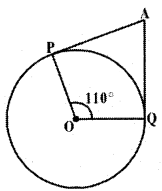
a) 60°
b) 70°
c) 80°
d) 90°
Answer: [ b ]
In □ OPAQ,
∠OPA = ∠OQA = 90°
∠POQ = 110°
∴ ∠O + ∠P + ∠A + ∠Q = 360°
⇒ 90° + 90° + 110° + ∠PAQ - 360°
⇒ ∠PAQ = 360° - 290° = 70°
iv) If tangents PA and PB from a point P to a circle with centre O are inclined to each other at angle of 80°, then ∠POA is equal to
- a) 50°
- b) 60°
- c) 70°
- d) 80°
Answer: [None]
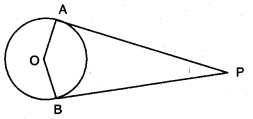
If ∠APB = 80°
then ∠AOB = 180° - 80° = 100°
[∴ ∠A + ∠B = 90° + 90° = 180°]
v) In the figure XY and XV are two parallel tangents to a circle with centre O and another tangent AB with point of contact C intersecting XY at A and XV at B then ∠AOB =
- a) 80°
- b) 100°
- c) 90°
- d) 60°
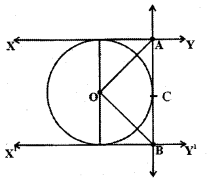
Answer: [ c ]
Question 2.
Two concentric circles of radii 5 cm and 3 cm are drawn. Find the length of the chord of the larger circle which touches the smaller circle.
Answer:
Given: Two circles of radii 3 cm and 5 cm with common centre.

Let AB be a tangent to the inner/small circle and chord to the larger circle.
Let ‘P’ be the point of contact.
Construction: Join OP and OB.
In △OPB ;
∠OPB = 90°
[radius is perpendicular to the tangent]
OP = 3cm OB = 5 cm
Now, OB2= OP2+ PB2
[hypotenuse2= Adj. side2+ Opp. side2, Pythagoras theorem]
52= 32+ PB2
PB2= 25 - 9 = 16
∴ PB = √l6 = 4cm.
Now, AB = 2 × PB
[∵ The perpendicular drawn from the centre of the circle to a chord, bisects it]
AB = 2 × 4 = 8 cm.
∴ The length of the chord of the larger circle which touches the smaller circle is 8 cm.
Question 3.
Prove that the parallelogram circumscribing a circle is a rhombus.
Answer:
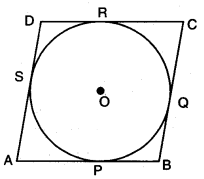
Given: A circle with centre ‘O’.
A parallelogram ABCD, circumscribing the given circle.
Let P, Q, R, S be the points of contact.
Required to prove: □ ABCD is a rhombus.
Proof: AP = AS …….. (1)
[∵ tangents drawn from an external point to a circle are equal]
BP = BQ ……. (2)
CR = CQ ……. (3)
DR = DS ……. (4)
Adding (1), (2), (3) and (4) we get
AP + BP + CR + DR = AS + BQ + CQ + DS
(AP + BP) + (CR + DR) = (AS + DS) + (BQ + CQ)
AB + DC = AD + BC
AB + AB = AD + AD
[∵ Opposite sides of a parallelogram are equal]
2AB = 2AD
AB = AD
Hence, AB = CD and AD = BC [∵ Opposite sides of a parallelogram]
∴ AB = BC = CD = AD
Thus □ ABCD is a rhombus (Q.E.D.)
Question 4.
A triangle ABC is drawn to circumscribe a circle of radius 3 cm such that the segments BD and DC into which BC is divided by the point of contact D are of length 9 cm. and 3 cm. respectively (See below figure). Find the sides AB and AC.
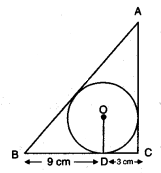
Answer:
The given figure can also be drawn as
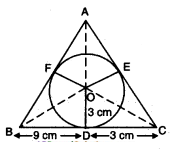
Given: Let △ABC be the given triangle circumscribing the given circle with centre ‘O’ and radius 3 cm.
i.e., the circle touches the sides BC, CA and AB at D, E, F respectively.
It is given that BD = 9 cm
CD = 3 cm
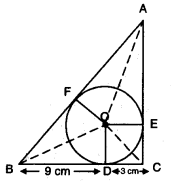
∵ Lengths of two tangents drawn from an external point to a circle are equal.
∴ BF = BD = 9 cm
CD = CE = 3 cm
AF = AE = x cm say
∴ The sides of die triangle are
12 cm, (9 + x) cm, (3 + x) cm
Perimeter = 2S = 12 + 9 + x + 3 + x
⇒ 2S = 24 + 2x
or S = 12 + x
S - a = 12 + x - 12 = x
S - b = 12 + x - 3 - x = 9
S - c = 12 + x - 9 - x = 3
∴ Area of the triangle
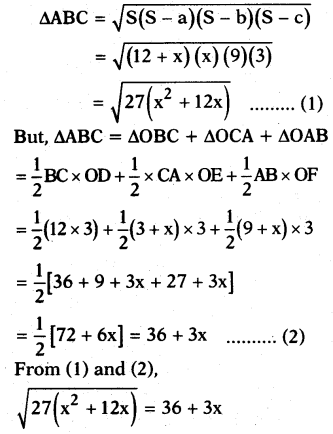
Squaring on both sides we get,
27 (x2+ 12x) = (36 + 3x)2
27x2+ 324x = 1296 + 9x2+ 216x
⇒ 18x2+ 108x- 1296 = 0
⇒ x2+ 6x - 72 = 0
⇒ x2+ 12x - 6x - 72 = 0
⇒ x (x + 12) - 6 (x + 12) = 0
⇒ (x - 6) (x + 12) = 0
⇒ x = 6 or - 12
But ‘x’ can’t be negative hence, x = 6
∴ AB = 9 + 6 = 15 cm
AC = 3 + 6 = 9 cm.
Question 5.
Draw a circle of radius 6 cm. From a point 10 cm away from its centre, construct the pair of tangents to the circle and measure their lengths. Verify by using Pythagoras Theorem.
Answer:
Steps of construction:
- Draw a circle with centre ‘O’ and radius 6 cm.
- Take a point P outside the circle such that OP =10 cm. Join OP.
- Draw the perpendicular bisector to OP which bisects it at M.
- Taking M as centre and PM or MO as radius draw a circle. Let the circle intersects the given circle at A and B.
- Join P to A and B.
- PA and PB are the required tan¬gents of lengths 8 cm each.
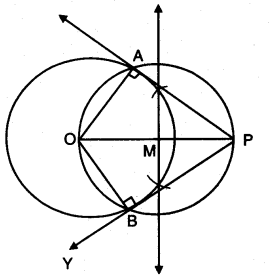
Proof: In △OAP
OA2+ AP2= 62+ 82
= 36 + 64 = 100
OP2= 102= 100
∴ OA2+ AP2= OP2
Hence AP is a tangent.
Similarly BP is a tangent.
Question 6.
Construct, a tangent to a circle of radius 4 cm from a point on the concentric circle of radius 6 cm and measure its length. Also verify the measurement by actual calculation.
Answer:
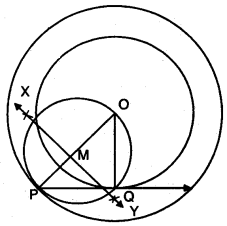
Steps of construction:
- Draw two concentric circles with centre ‘O’ and radii 4 cm and 6 cm.
- Take a point ‘P’ on larger circle and join O, P.
- Draw the perpendicular bisector of OP which intersects it at M.
- Taking M as centre and PM or MO as radius draw a circle which intersects smaller circle at Q.
- Join PQ, which is a tangent to the smaller circle.
Question 7.
Draw a circle with the help of a bangle, take a point outside the circle. Con-struct the pair of tangents from this point to the circle measure them. Write conclusion.
Answer:
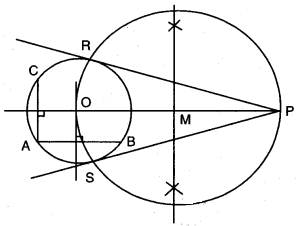
Steps of construction:
- Draw a circle with the help of a bangle.
- Draw two chords AB and AC. Perpendicular bisectors of AB and AC meets at ‘O’ which is the centre of the circle.
- Taking an outside point P, join OP.
- Let M be the midpoint of OP. Taking M as centre OM as radius, draw a circle which intersects the given circle at R and S. Join PR, PS which are the required tangents.
Conclusion: Tangents drawn from an external point to a circle are equal.
Question 8.
In a right triangle ABC, a circle with a side AB as diameter is drawn to intersect the hypotenuse AC in P. Prove that the tangent to the circle at P bisects the side BC.
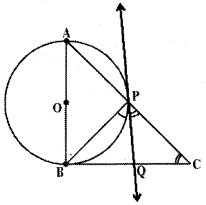
Answer:
Let ABC be a right triangle right angled at P.
Consider a circle with diametere AB.
From the figure, the tangent to the circle at B meets BC in Q.
Now QB and QP are two tangents to the circle from the same point P.
QB = QP …….. (1)
Also, ∠QPC = ∠QCP
∴ PQ = QC (2)
From (1) and (2);
QB = QC Hence proved.
Question 9.
Draw a tangent to a given circle with center O from a point ‘R’ outside the circle. How many tangents can be drawn to the circle from that point? [Hint: The distance of two points to the point of contact is the same.
Answer:
Only two tangents can be drawn from a given point outside the circle.
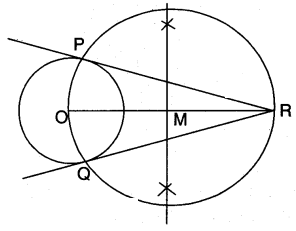
Question 1.
A chord of a circle of radius 10 cm. subtends a right angle at the centre. Find the area of the corresponding: (use π = 3.14)
i) Minor segment ii) Major segment
Answer:
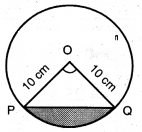
Angle subtended by the chord = 90° Radius of the circle = 10 cm
Area of the minor segment = Area of the sector POQ - Area of △POQ
Area of the sector = x/360 × πr2
90/360 × 3.14 × 10 × 10 = 78.5
Area of the triangle =12× base × height
= 1/2 × 10 × 10 = 50
∴ Area of the minor segment = 78.5 - 50 = 28.5 cm2
Area of the major segment = Area of the circle - Area of the minor segment
= 3.14 × 10 × 10 - 28.5
= 314 - 28.5 cm2
= 285.5 cm2
Question 2.
A chord of a circle of radius 12 cm. subtends an angle of 120° at the centre. Find the area of the corresponding minor segment of the circle.
(use π = 3.14 and √3 = 1.732)
Answer:
Radius of the circle r = 12 cm.
Area of the sector = x/360 × πr2
Here, x = 120°
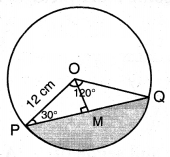
120/360 × 3.14 × 12 × 12 = 150.72
Drop a perpendicular from ‘O’ to the chord PQ.
△OPM = △OQM [∵ OP = OQ ∠P = ∠Q; angles opp. to equal sides OP & OQ; ∠OMP = ∠OMQ by A.A.S]
∴ △OPQ = △OPM + △OQM = 2 . △OPM
Area of △OPM = 1/2 × PM × OM
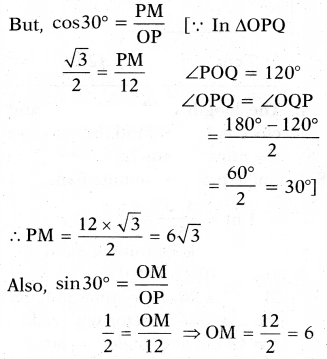
= 18 × 1.732 = 31.176 cm
∴ △OPQ = 2 × 31.176 = 62.352 cm2
∴ Area of the minor segment

= (Area of the sector) - (Area of the △OPQ)
= 150.72 - 62.352 = 88.368 cm2
Question 3.
A car has two wipers which do not overlap. Each wiper has a blade of length 25 cm. sweeping through an angle of 115°. Find the total area cleaned at each sweep of the blades. (use π =22/7)
Answer:
Angle made by the each blade = 115°
Total area swept by two blades
= Area of the sector with radius 25 cm and angle 115°+ 115° = 230°
= Area of the sector = x/360 × πr2
=230/360 × 22/7 × 25 × 25
= 1254.96
≃ 1255 cm2
Question 4.
Find the area of the shaded region in figure, where ABCD is a square of side 10 cm. and semicircles are drawn with each side of the square as diameter (use π = 3.14).
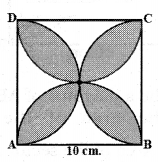
Answer:
Let us mark the four unshaded regions as I, II, III and IV.
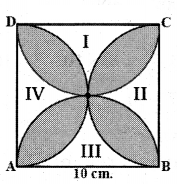
Area of I + Area of II
= Area of ABCD - Areas of two semicircles with radius 5 cm
= 10 × 10 - 2 × 1/2 × π × 52
= 100 - 3.14 × 25
= 100 - 78.5 = 21.5 cm2
Similarly, Area of II + Area of IV = 21.5 cm2
So, area of the shaded region = Area of ABCD - Area of unshaded region
= 100 - 2 × 21.5 = 100 - 43 = 57 cm2
Question 5.
Find the area of the shaded region in figure, if ABCD is a square of side 7 cm. and APD and BPC are semicircles. (use π = 22/7)
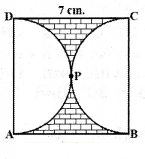
Answer:
Given,
ABCD is a square of side 7 cm.
Area of the shaded region = Area of ABCD - Area of two semicircles with radius 7/2 = 3.5 cm
APD and BPC are semicircles.
= 7 × 7 - 2 × 1/2 × 22/7 × 3.5 × 3.5
= 49 - 38.5
= 10.5 cm2
∴ Area of shaded region = 10.5 cm
Question 6.
In figure, OACB is a quadrant of a circle with centre O and radius 3.5 cm. If OD = 2 cm., find the area of the shaded region, (use π = 22/7).
Answer:
Given, OACB is a quadrant of a Circle.
Radius = 3.5 cm; OD = 2 cm.
Area of the shaded region = Area of the sector - Area of △BOD
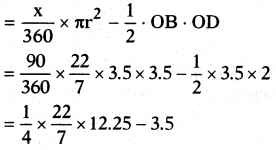
= 9.625 - 3.5 = 6.125 cm2
∴ Area of shaded region = 6.125 cm2.
Question 7.
AB and CD are respectively arcs of two concentric circles of radii 21 cm. and 7 cm. with centre O (See figure). If ∠AOB = 30°, find the area of the shaded region. (use π = 22/7).
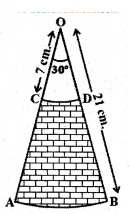
Answer:
Given, AB and CD are the arcs of two concentric circles.
Radii of circles = 21 cm and 7 cm and ∠AOB = 30°
We know that,
Area of the sector = x/360 × πr2
Area of the shaded region = Area of the OAB - Area of OCD
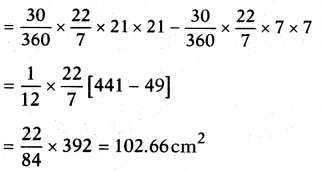
∴ Area of shaded region = 102.66 cm2
Question 8.
Calculate the area of the designed region in figure, common between the two quadrants of the circles of radius 10 cm each, {use π = 3.14)
Answer:
Mark two points P, Q on the either arcs.
Let BD be a diagonal of ABCD
Now the area of the segment
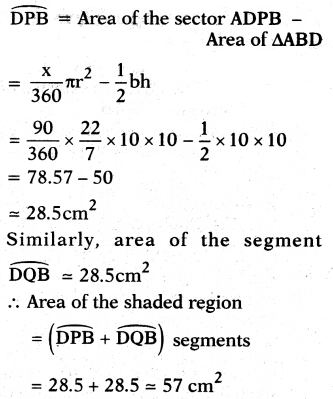
= 28.5 + 28.5 = 57 cm2
Side of the square = 10 cm
Area of the square = side × side
= 10 × 10 = 100 cm2
Area of two sectors with centres A and C and radius 10 cm.
= 2 × ?r2/360 × x = 2 × x/360 × 22/7 × 10 × 10
=1100/7
= 157.14 cm2
∴ Designed area is common to both the sectors,
∴ Area of design = Area of both sectors - Area of square
= 157 - 100 = 57 cm2
(or)
1100/7 - 100 = 1100?700/7
=400/7
= 57.1 cm2